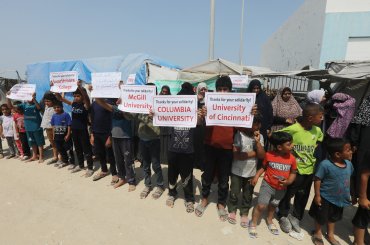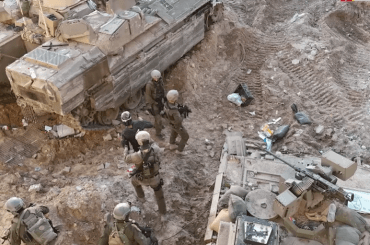Yossi Melman has revealed in Ha’aretz that the Iron Dome missile, developed at great expense and fanfare by Rafael Advanced Defence Systems, will not be used to protect the southern Israeli towns of Sderot and Ashkelon, the mission for which it was presumably developed. This in spite of a pledge by the Obama Administration to provide $205 million for its development and deployment. It is now apparent that Iron Dome will be instead used for army bases only in Israel and will be sold to Singapore, which partially funded its development.
The revelation that Iron Dome will not be used for Sderot is the conclusion of an extraordinarily cynical and exploitive episode for Israel’s security establishment.
For the past several years, the southern Israeli town of Sderot and Ashkelon suffered attacks by Qassam missile launched from Gaza by Hamas militants. As I followed the news, it hurt to hear the stories of the individuals, including children, maimed or killed at random. (This was before my internet reading began to take in a detailed look at the Palestinian suffering in Gaza due to the IDF as well.) I remember the story of a student at Sapir College, Roni Yechiah, a father of four who was killed in the parking lot. Twenty-eight deaths and hundreds of injuries have been caused by the Qassam attacks.
Where was the much-vaunted Israeli ingenuity? Israel has done great things, most famously Operation Entebbe, where hijacked Israelis were rescued from Entebbe, Uganda in 1976. This was straightforward and morally uncomplicated. Israelis were in mortal danger, and the security establishment formulated a plan to save them and it was executed brilliantly. With the Qassam missiles against Sderot, a plan of rescue was clearly visible, and discussed in the media, yet year after year rolled by without any sort of defense of the population.
How hard is defense against short-range rockets?
Short range missiles and mortars can be stopped with a reasonable, 80-90% success rate using a Gatling gun guided by radar. The US and international forces in Iraq have used a system called C-RAM , which is a variant of the system usually used on ships to provide a last-ditch defense against missiles. Defense Minister Ehud Barak evaluated the gun-based system, also called Vulcan-Phalanx, and determined that it was the only system which was available to protect Sderot as a community. Independent experts evaluated that the number of gun emplacements needed to protect the city was three or four. No Vulcan-Phalanxes have, as of yet, been obtained or deployed.
The Road Not Travelled
In other words, the defense of Sderot, or lack thereof, was a relatively small issue to the defense establishment, which has focused on Iran for some years. The Israeli Air Force has preferred to spend its resources on offensive capabilities, such as additional fighter planes, not defensive capabilities. However, the failure to address defense of Sderot ultimately led to the need for an offensive solution. Operation Cast Lead was the invasion of Gaza, conducted Dec. 27, 2008 to Jan 18, 2009.
When the invasion happened, I followed it superficially on American television. I had known about the attacks on Sderot, so I felt that it was definitely morally justified. It was a real pity that Israel hadn’t pursued the sensible path of defense, but still, Hamas had chosen to fire missiles at Israel, and the moral responsibility was on them. It took until 2010 before I began to look into the criticism that I had been hearing.
Operation Cast Lead, according to Norman Finkelstein, wasn’t a war at all, but a totally one-sided massacre of a defenseless population. Hamas killed a total of 4 Israeli soldiers, compared with 1,417 Palestinians, one-third of whom were children. Furthermore, the apparently “moral” actions of the IDF, such as warning Palestinian civilians via text messages, or hitting buildings with missiles that lacked warheads, as a warning (so called “knock-on-the-roof”) It became clear that this was window dressing meant for the media, and it fact horrific war crimes were taking place. As revealed by the Israeli group Breaking the Silence, the plan was to kill 2000 “terrorists”, with little distinction made as to who was really a terrorist.
The result of Operation Cast Lead was condemnation throughout Europe and the rest of the world. The Gaza invasion badly damaged Israeli moral standing and credibility. It was considered to be a tactical victory but a strategic failure.When one considers that Hamas barely fought at all during the war, calling it a “tactical victory” is rather ridiculous.
When you look at the admitted strategic failure of Operation Cast Lead, you have to turn back to what could have been, had it been decided to use missile defense. Had the numbers of casualties been radically less, even if not zero, there would not have been the political impetus for the invasion of Gaza. Israel gave itself grave moral damage, and devastated thousands of Palestinian lives, in part because of a self-oriented defense community that lied to itself and to the Israeli public about its intentions.
Why did this happen?
Yossi Melman has chronicled this story for three years, and feels that the story has come to its conclusion. He wrote,
Suggestions for an intermediate (rocket defense) solution until Iron Dome was ready, including cheaper and more accessible systems such as the Vulcan Phalanx, which has proved its ability to intercept missiles in Iraq and Afghanistan, or restarting the development of a laser cannon, were rejected by defense ministry bureaucrats with lies.
There are suspicions that this was done out of the concern that the Vulcan and laser could actually work and their success would have torpedoed Iron Dome.
And here the story ends. In 2010, Rafael partially fulfilled its mission in record time. It developed a model which is stored at a southern Israel air force base, and a few more launchers at other bases. But the army refuses to deploy them to protect the home front.
GOC Northern Command Gadi Eizenkot recently made this point clear as day, stating that Iron Dome is not meant to defend civilians, but only army bases. In other words, an army general has admitted that everything that has been said to the public about the purpose of the billion shekel investment in the Iron Dome project to improve public security is one big lie.
The behavior of the army and the defense system in this affair is shamelessly cynical, proof of the contempt of bureaucrats and decision-makers for the public and its money, and who have the feeling that they can make fools of the public without being asked to give explanations and without taking responsibility for their actions.
What does this say about the defense establishment, and the morality of decision making processes? If the events of Entebbe in 1976 took place today, would the response have been a confused mess, indecision, political infighting, and ultimate failure? The story of the failure to defend Sderot shows that when it comes to security the “tail wags the dog”. The politics of the defense industry and the military had more relative importance that the safety of the citizens of the south.
The non-defense of Sderot also strongly suggests that the leadership felt that attacks on Sderot were more advantageous as a source of sympathy for Israel than was the imperative to defend the citizens. This issue of Israel seeing advantage in enabling its enemies, in order to generate world sympathy, has been seen in other conflicts. It shows that the Israeli leadership is distracted from straightforward, logical solutions to security problems and is pursuing interests other than the issue at hand.
Robert is the first name of an investor who has studied physics and aerospace and follows Israel issues. He lived in Israel as a toddler and honeymooned there three years ago.

